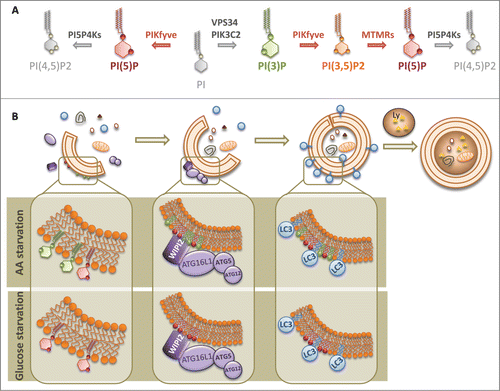Figures & data
Figure 1. PI(5)P regulates autophagosome biogenesis. (A) Schematic representation of pathways for PI(5)P synthesis/turnover and enzymes involved in these pathways. PI5P4K, type II phosphatidylinositol 5-phosphate 4-kinase; PIKfyve, type III phosphatidylinositol 5-phosphate 5-kinase; VPS34, class III phosphatidylinositol 3-kinase; PIK3C2A, class II phosphatidylinositol 3-kinase; MTMR, myotubularin related 3-phosphatase. (B) PI(5)P (red) is found on pre-phagophore structures, phagophores, and autophagosomes, and stabilizes membrane-bound WIPI2 on autophagic precursors. WIPI2 binding recruits the ATG16L1-5-12 complex, which enables phagophore biogenesis and subsequent LC3 lipidation and autophagic substrate degradation. PI(5)P metabolism on autophagosomes seems to be highly dependent on PIKfyve and PI5P4K activities. Importantly, although we found that PI(3)P (green) was required for amino acid starvation-induced autophagy, PI(5)P synthesis was essential for autophagy activation by both amino acid and glucose depletion. Thus, we have identified PI(5)P as a new master regulator of glucose starvation-induced autophagy through a PI(3)P-independent autophagy pathway.

